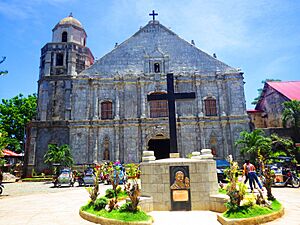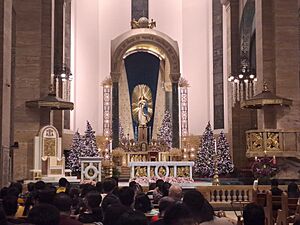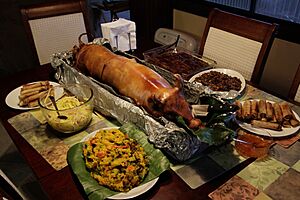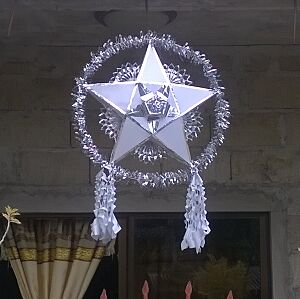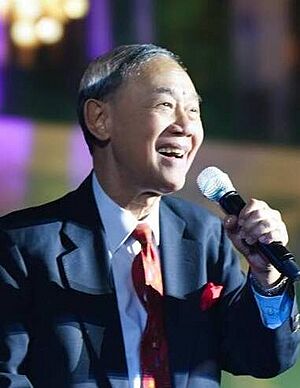Christmas in the Philippines facts for kids
Christmas in the Philippines is a huge and joyful celebration, just like in many Christian countries around the world. It's a public holiday on December 25th. The Philippines is one of only two mostly Catholic countries in Asia, and it's famous for having the longest Christmas season in the world!
This special time, called Kapaskuhan, starts as early as September, which people call the "ber months" (like September, October). You'll hear Christmas music and see decorations everywhere! The celebrations get really exciting in December and usually finish a week after New Year's Day. Some families even extend the fun until the third Sunday of January, celebrating the feast of the Santo Niño. For others, the season might last until February 2nd, with the feast of the Candelaria, when decorations are finally put away.
Contents
- What's in a Name? The Word "Pasko"
- A Look Back: How Christmas Began in the Philippines
- How Filipinos Celebrate: Traditions and Customs
- Religious Practices: Faith and Festivities
- Cultural and Social Traditions: Food, Family, and Fun
- Symbols and Media: The Look and Sound of Christmas
- Other Religions and Secular Observances
- Economy: Christmas and the Philippine Economy
- Images for kids
- See also
What's in a Name? The Word "Pasko"
In the Philippines, the most common word for Christmas is Pasko. This word comes from the Spanish phrase pascua de navidad, which means "Easter of the Nativity." Over many years, the Spanish word pascua became part of local languages and was shortened to Pasko.
Other languages in the Philippines also have their own names for Christmas. For example, in Kapampangan, it's Pasku or Pascu. In Chavacano, Hiligaynon, and Ilocano, people still use words similar to the Spanish pascua. Sometimes, you might even hear Krismas, which is a Filipino way of saying "Christmas."
Christmas Day is called Araw ng Pasko, and the night before, Christmas Eve, is Bisperas ng Pasko. Many other Filipino words related to Christmas come from Pasko, like Kapaskuhán (the Christmas season) and pamaskó (a Christmas gift).
Pamamaskó also describes when children visit relatives and godparents during Christmas. They offer greetings and songs, and in return, they receive gifts of money or food. This custom usually happens after attending Christmas Day Mass.
A Look Back: How Christmas Began in the Philippines
Early Stories and First Celebrations
Some old stories say that Christmas was first celebrated in the Philippines way back in 1324 by an Italian missionary named Odoric. He supposedly held a Catholic Mass in Bolinao, Pangasinan. However, historians say there isn't enough proof for this story. The first officially recorded Catholic Mass in the Philippines happened much later, in 1521, on Easter Sunday in Mazaua (now Limasawa).
Before Christianity arrived in the 1500s, people in the Philippines had their own special celebrations tied to farming and their beliefs in spirits. When the Spanish came and brought Catholicism, many of these local traditions slowly blended with Christian holidays, including Christmas. This mix of old and new customs helped create the unique Filipino Christmas we know today.
The first documented Christmas celebration in the Philippines happened in December 1565 in Cebu, after the Spanish explorer Miguel López de Legazpi set up the first permanent Spanish settlement there.
Spanish Influence: Simbang Gabi and Nochebuena
One of the most cherished Filipino Christmas traditions is Simbang Gabi, which means "night Mass." This is a series of nine early morning Masses held from December 16th to 24th, leading up to Christmas. It started in Spain and came to the Philippines through Mexican missionaries.
Originally, these Masses were held before midnight. But by the 1700s, they were moved to early dawn so that farmers could attend before going to work in the fields. This is why it's also called Misa de Gallo, or "rooster's Mass," because it happens when roosters crow at daybreak. During Simbang Gabi, churches are beautifully decorated with lights and star-shaped lanterns called parol. After Mass, people often enjoy delicious native treats like bibingka and puto bumbong. Many believe that if you complete all nine Masses, a special wish will come true!
After the last Simbang Gabi on Christmas Eve, families gather for nochebuena, a special midnight feast. This meal, which includes ham, roasted meats, and rice cakes, is a tradition from Spanish times and is a wonderful way for families to start their Christmas celebration together.
American Era: New Traditions Arrive
When the Philippines became a territory of the United States in 1898, new Christmas traditions arrived. Things like Christmas cards, Christmas trees, Santa Claus, and English Christmas songs became popular. Department stores in Manila started having fancy window displays to attract shoppers. These Western symbols mixed with the existing Filipino traditions like Simbang Gabi and nochebuena.
During World War II, when Japan occupied the Philippines (1942–1945), Christmas celebrations were very quiet. There were blackouts and food shortages, but families still found ways to have small gatherings and religious services.
Modern Christmas: The Longest Season
After the Philippines gained independence in 1946, Christmas celebrations grew even bigger. The "ber months" tradition, where the season starts in September, became very popular. The city of San Fernando, Pampanga, became known as the "Christmas Capital of the Philippines" because of its amazing parol lanterns and the annual Giant Lantern Festival.
Filipino composers like José Mari Chan created many popular Christmas songs that you hear everywhere during the season. The Christmas season also extends to other feasts, like Three Kings' Day in early January and the Santo Niño festivals like Sinulog and Ati-Atihan later in January. This is why Christmas in the Philippines is known as the longest in the world!
How Filipinos Celebrate: Traditions and Customs
The Philippines is mostly a Catholic country, and Christmas is celebrated for almost half the year, from September to January! This long celebration mixes fun, festive activities with important religious practices. Both Christmas Eve (December 24) and Christmas Day (December 25) are public holidays.
Filipino Christmas traditions are a blend of local, Spanish, and American customs. Family and the birth of Jesus are at the heart of the celebrations. You'll see lanterns, decorations, and hear lots of music, showing both religious devotion and community joy. Even Santa Claus has become a popular figure!
Some people feel the season has become too focused on shopping, but the Catholic Church reminds everyone that the true meaning of Christmas is about faith, family, and being together.
Religious Practices: Faith and Festivities
Simbang Gabi and Misa de Gallo: Dawn Masses
Simbang Gabi means "night Mass," but these are actually nine early morning Masses held from December 16th to 24th. Many Catholics and other Christian groups attend these Masses to show their devotion and get ready for the birth of Jesus. A popular belief is that if you complete all nine Masses, a special wish will be granted!
These Masses usually start around 4:30 AM, but some can be earlier or later. Many churches also have evening Masses for those who can't make it in the morning. The series of Masses ends with the Misa de Gallo, the traditional midnight Mass on Christmas Eve, right before the family nochebuena feast.
Panunulúyan: The Journey of Mary and Joseph

Panunulúyan is a special play that reenacts the story of Mary and Joseph looking for a place to stay in Bethlehem before Jesus was born. These plays are often performed on Christmas Eve before the Misa de Gallo. Actors play Joseph and Mary, going from house to house, asking for lodging. Each house (acting as an inn) refuses them until they reach the church, where a stable (called a belén) is set up, and the Christmas Eve Mass begins.
Christmas Eve: The Nochebuena Feast
Christmas Eve (Bisperas ng Pasko) on December 24th is a very important night. Families gather for nochebuena, a midnight feast. This meal often includes delicious dishes like queso de bola (a round, red cheese), hot chocolate (tsokolate), pancit or pasta, fruit salad, pandesal (bread rolls), relyeno (stuffed chicken), and hamon (Christmas ham). Some families also open their presents during or after this special meal.
Christmas Day: Family and Blessings
Christmas Day (Araw ng Pasko) is all about family. Filipinos traditionally visit their relatives, especially older family members, to show respect. This custom is called págmamáno. You take an elder's hand and gently press it to your forehead while saying máno, pô. The elder usually gives a blessing and often gives aguinaldo (money or gifts), especially to their godchildren.
Post-Christmas Celebrations: Keeping the Spirit Alive
Niños Inocentes: A Day for Pranks
On December 28th, Filipinos celebrate Niños Inocentes, or Holy Innocents Day. This day is a bit like April Fools' Day, where people play harmless practical jokes. A common prank is to borrow money without planning to pay it back right away, then exclaim, Na-Niños Inocentes ka! (You've been tricked for Holy Innocents' Day!).
New Year's Eve and New Year's Day: Welcoming the Future
New Year's Eve and New Year's Day are big parts of the Christmas season. On December 31st, families have a midnight feast called medianoche. They often serve twelve round fruits for good luck and dishes like pancit for a long life. Sticky rice treats are also popular, symbolizing family togetherness. At midnight, people make lots of noise with firecrackers, horns, and kitchenware to scare away bad spirits. Many also attend Mass on New Year's Eve or New Year's Day. Cities host concerts and fireworks to welcome the new year.
Three Kings' Day: Gifts from the Magi
Christmas officially ends on Three Kings' Day, also known as Epiphany. This day falls on the first Sunday after New Year's Day. In some communities, children still leave their shoes out to receive small gifts from the Three Kings, though this tradition is becoming less common.
Feast of the Santo Niño: A Grand Finale
The very last day of popular Christmas celebrations is often the feast of the Santo Niño (the Child Jesus) on the third Sunday of January. This day honors the first Christian image brought to the Philippines and is celebrated with huge festivals like the Sinulog in Cebu, the Ati-Atihan in Aklan, and the Dinagyang in Iloilo.
Feast of Our Lady of Candelaria: A Final Blessing
In older traditions, the Christmas season lasted until February 2nd, known as Candlemas. This day celebrates the purification of Mary and the presentation of Baby Jesus at the Temple. A special celebration for Our Lady of Candelaria takes place in Jaro, Iloilo City.
Cultural and Social Traditions: Food, Family, and Fun
Delicious Christmas Food: A Feast for Everyone
Filipino Christmas food is a wonderful mix of Spanish flavors and local specialties. During nochebuena, families often serve roasted meats like lechon (roasted pig) and hamon (Christmas ham). Other festive dishes include embutido (meatloaf), morcon (stuffed meat roll), Filipino spaghetti, pancit, and special rice dishes like bringhe or paelya. You might also find queso de bola (Edam cheese) and delicious desserts.
Sweet treats are a big part of the celebration. Bibingka and puto bumbong are popular during Simbang Gabi, sold outside churches and served with butter and grated coconut. Other favorites include suman (sticky rice cakes), maja blanca (coconut pudding), fruit salad, leche flan, and ube halaya (purple yam jam). These are often enjoyed with hot chocolate (tsokolate) or ginger tea (salabat).
Giving and Gathering: Family Customs
Gift Giving: Sharing Joy
Giving gifts is a very important part of Christmas in the Philippines. Presents are usually exchanged during nochebuena or on Christmas Day. Godparents (ninong for male, ninang for female) traditionally give aguinaldo (cash gifts) to their godchildren (inaanaks) when they visit. Schools and offices often have gift exchanges, like Monito-Monita.
Monito-Monita is like the Filipino version of Secret Santa. The names monito and monita come from Spanish words for "little brother" and "little sister," or sometimes playfully, "little monkey." Participants draw names and secretly give small gifts to their assigned person. Their identities are revealed at a holiday party, often with fun themes for the gifts like "something sweet" or "something useful."
Family Reunions: Coming Together
Christmas is also a special time for family reunions. Extended families gather during the holidays, often with games, talent shows, gift exchanges, and big meals. These gatherings help strengthen family bonds across generations.
Symbols and Media: The Look and Sound of Christmas
Decorations: Lights, Stars, and Nativity Scenes
Filipino Christmas decorations combine traditional symbols with modern ones. You'll see Santa Claus, Christmas trees, tinsel, and Christmas lights everywhere.
Parol: The Star Lantern
The parol is a beautiful star-shaped lantern, a very famous Filipino Christmas decoration. It symbolizes the Star of Bethlehem that guided the Three Kings. The word parol comes from the Spanish word for "lantern." Early parols were made from bamboo and paper, lit by candles. Over time, they became more colorful and now often use electric lights.
The city of San Fernando, Pampanga, is famous for making parols. They even have an annual Giant Lantern Festival (Ligligan Parul) where huge, motorized lanterns with synchronized lights and music are showcased. This has made San Fernando the "Christmas Capital of the Philippines."
Belen: The Nativity Scene
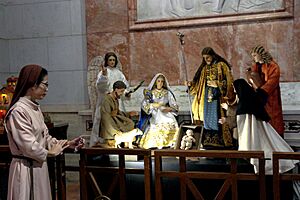
Another important Filipino Christmas symbol is the belen, which is a nativity scene showing the birth of Jesus. The name belen comes from the Spanish word for Bethlehem. A belen usually shows baby Jesus in a manger with Mary, Joseph, shepherds, the Magi, angels, and stable animals. Often, a parol is placed above it, representing the Star of Bethlehem.
Belens were brought by the Spanish in the 1500s and are still a central part of Christmas in the Philippines. You'll see them in homes, churches, schools, and public places. Tarlac City even has an annual "Belenismo sa Tarlac" contest to promote belen-making, earning it the title "Belen Capital of the Philippines."
Music and Carols: The Sounds of the Season
Music is a huge part of the Filipino Christmas season, with carols often heard as early as August! Street carolers, usually groups of children, go from house to house singing songs in exchange for coins. This tradition is a fun way to spread cheer and help poorer communities earn some money.
There are many traditional carols, often with religious themes, sung in churches and community gatherings. Some popular ones include "Ang Pasko ay Sumapit," "Sa Maybahay Ang Aming Bati," and "Himig ng Pasko."
Modern Filipino pop songs and ballads have also become very popular during Christmas. You'll hear them in malls and on the radio as soon as the "ber months" begin. These include Jose Mari Chan's famous "Christmas in Our Hearts," "Pasko Na, Sinta Ko," and "Star ng Pasko." This mix of old and new songs creates a wonderful festive atmosphere throughout the long holiday season.
English-language and Western Christmas songs are also very common, played alongside Filipino carols in public places. This blend of local and international music helps create a unique Filipino Christmas identity.
Literature, Films, and TV: Christmas Stories and Shows
Christmas is a popular theme in Filipino books, short stories, poems, and essays. Many stories focus on faith, family, and community, often featuring traditions like Simbang Gabi and the parol.
The Metro Manila Film Festival (MMFF) is held every year starting on December 25th. This festival showcases only Filipino films and is a big part of the holiday season, with many families watching movies together.
Television networks also create special holiday shows, musical programs, and year-end features. News programs often mark the start of the "ber months" and count down to Christmas. Major TV networks like ABS-CBN, GMA, and TV5 release annual Christmas station IDs with original songs, which are eagerly awaited and played throughout the season. You'll also see reruns of popular foreign Christmas films like Home Alone and The Polar Express.
Other Religions and Secular Observances
While Christmas is mainly a Christian holiday in the Philippines, non-Christian communities also take part in the season in different ways. Many enjoy the fun, non-religious parts, like parties, decorations, and gift-giving, without celebrating it as a religious event.
Muslims, for example, might join Christmas parties to show goodwill, as long as the activities don't go against their Islamic beliefs.
The Iglesia ni Cristo (INC) does not celebrate Christmas, as they believe it is not based on the Bible. Instead, they hold a Year-end Thanksgiving worship service every December, which is a special community event for them.
Economy: Christmas and the Philippine Economy

The long Philippine Christmas season has a big impact on the country's economy. It brings in a lot of money through gifts, bonuses, and money sent home by Filipinos working abroad. This boosts shopping and services, creates temporary jobs, and helps many people earn income.
Shopping, Remittances, and Bonuses
Christmas is the biggest time for household spending. Families often spend more than three times their usual monthly income on gifts, food, and celebrations.
Money sent home by Overseas Filipino Workers (OFWs) increases a lot in the months leading up to December. This provides a huge cash boost for families to spend. Also, many workers receive their mandatory 13th month pay and other Christmas bonuses, which further increases spending. The Department of Labor and Employment (DOLE) requires that 13th month pay be given out on or before December 24th.
Commerce, Jobs, and Tourism
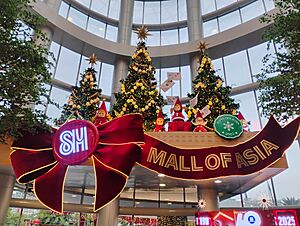
Malls, department stores, and online shops see a big increase in sales starting as early as September. Online shopping also grows, meaning courier companies hire more people. Electricity use and transportation also increase due to mall operations, festive lights, and holiday travel. The holiday demand creates temporary jobs in retail, food service, crafts, and tourism. Small businesses, like parol makers in Pampanga, also benefit greatly from seasonal orders.
Christmas celebrations also boost domestic tourism. Local governments host light displays, festivals, and themed attractions, creating jobs and revenue. Many Filipinos travel home or go on vacation, increasing earnings for hotels, restaurants, and transportation. Demand for traditional nochebuena foods like lechon and hamon also rises sharply.
Images for kids
-
Parols and Christmas lights on display at night. The parol is regarded as one of the most recognizable symbols of the Filipino Christmas season.
-
Staircases at UP Manila with greetings in several Philippine languages, roughly saying "[Let us] meet and join. Christmas is fun at UP Manila."
See also
- Festivals in the Philippines
- Holy Week in the Philippines
- Public holidays in the Philippines


